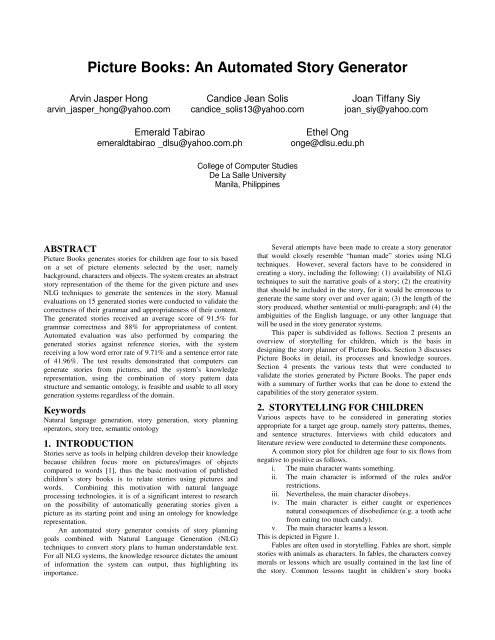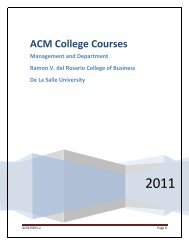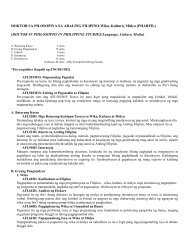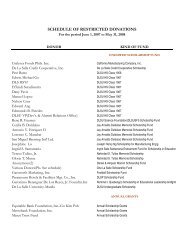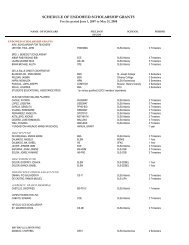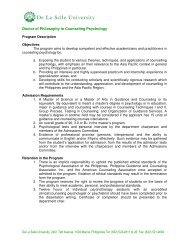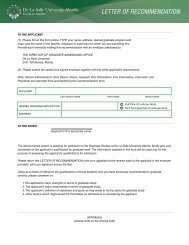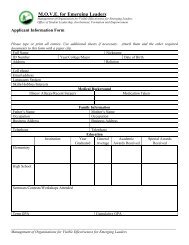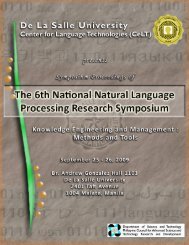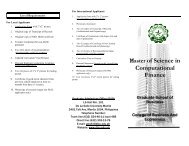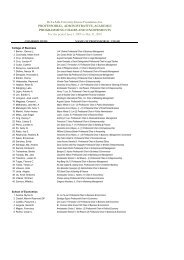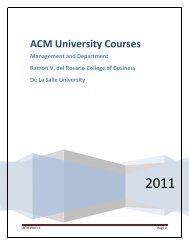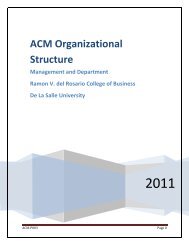Picture Books: An Automated Story Generator - De La Salle University
Picture Books: An Automated Story Generator - De La Salle University
Picture Books: An Automated Story Generator - De La Salle University
Create successful ePaper yourself
Turn your PDF publications into a flip-book with our unique Google optimized e-Paper software.
<strong>Picture</strong> <strong>Books</strong>: <strong>An</strong> <strong>Automated</strong> <strong>Story</strong> <strong>Generator</strong>Arvin Jasper Hongarvin_jasper_hong@yahoo.comCandice Jean Soliscandice_solis13@yahoo.comJoan Tiffany Siyjoan_siy@yahoo.comEmerald Tabiraoemeraldtabirao _dlsu@yahoo.com.phEthel Ongonge@dlsu.edu.phCollege of Computer Studies<strong>De</strong> <strong>La</strong> <strong>Salle</strong> <strong>University</strong>Manila, PhilippinesABSTRACT<strong>Picture</strong> <strong>Books</strong> generates stories for children age four to six basedon a set of picture elements selected by the user, namelybackground, characters and objects. The system creates an abstractstory representation of the theme for the given picture and usesNLG techniques to generate the sentences in the story. Manualevaluations on 15 generated stories were conducted to validate thecorrectness of their grammar and appropriateness of their content.The generated stories received an average score of 91.5% forgrammar correctness and 88% for appropriateness of content.<strong>Automated</strong> evaluation was also performed by comparing thegenerated stories against reference stories, with the systemreceiving a low word error rate of 9.71% and a sentence error rateof 41.96%. The test results demonstrated that computers cangenerate stories from pictures, and the system’s knowledgerepresentation, using the combination of story pattern datastructure and semantic ontology, is feasible and usable to all storygeneration systems regardless of the domain.KeywordsNatural language generation, story generation, story planningoperators, story tree, semantic ontology1. INTRODUCTIONStories serve as tools in helping children develop their knowledgebecause children focus more on pictures/images of objectscompared to words [1], thus the basic motivation of publishedchildren’s story books is to relate stories using pictures andwords. Combining this motivation with natural languageprocessing technologies, it is of a significant interest to researchon the possibility of automatically generating stories given apicture as its starting point and using an ontology for knowledgerepresentation.<strong>An</strong> automated story generator consists of story planninggoals combined with Natural <strong>La</strong>nguage Generation (NLG)techniques to convert story plans to human understandable text.For all NLG systems, the knowledge resource dictates the amountof information the system can output, thus highlighting itsimportance.Several attempts have been made to create a story generatorthat would closely resemble “human made” stories using NLGtechniques. However, several factors have to be considered increating a story, including the following: (1) availability of NLGtechniques to suit the narrative goals of a story; (2) the creativitythat should be included in the story, for it would be erroneous togenerate the same story over and over again; (3) the length of thestory produced, whether sentential or multi-paragraph; and (4) theambiguities of the English language, or any other language thatwill be used in the story generator systems.This paper is subdivided as follows. Section 2 presents anoverview of storytelling for children, which is the basis indesigning the story planner of <strong>Picture</strong> <strong>Books</strong>. Section 3 discusses<strong>Picture</strong> <strong>Books</strong> in detail, its processes and knowledge sources.Section 4 presents the various tests that were conducted tovalidate the stories generated by <strong>Picture</strong> <strong>Books</strong>. The paper endswith a summary of further works that can be done to extend thecapabilities of the story generator system.2. STORYTELLING FOR CHILDRENVarious aspects have to be considered in generating storiesappropriate for a target age group, namely story patterns, themes,and sentence structures. Interviews with child educators andliterature review were conducted to determine these components.A common story plot for children age four to six flows fromnegative to positive as follows.i. The main character wants something.ii. The main character is informed of the rules and/orrestrictions.iii. Nevertheless, the main character disobeys.iv. The main character is either caught or experiencesnatural consequences of disobedience (e.g. a tooth achefrom eating too much candy).v. The main character learns a lesson.This is depicted in Figure 1.Fables are often used in storytelling. Fables are short, simplestories with animals as characters. In fables, the characters conveymorals or lessons which are usually contained in the last line ofthe story. Common lessons taught in children’s story books
include being honest, being brave, value of sharing, beingcheerful, eating fruits and vegetables, being polite, keeping one’stoys, and helping at home.Figure 2 Theme Data StructureFigure 1 Common and Classic <strong>Story</strong> Pattern Form [4]Stories for four year olds have simple sentence structuresand contain line redundancy. This is lessened as the child growsolder. Words used should also be simple and easy to understand.Positive adjectives describing what the child must do are used.The words used to describe things vary depending on the age ofthe child. For example, it is appropriate to use the word happy fora four-year old child, merry for five-year old and delightful forsix-year old.<strong>An</strong>other aspect to consider in storytelling is the story’s title.<strong>Story</strong> titles are short and often contain the story’s theme as a hintto what the story is about. The main character’s name should alsobe included in the title [8].3.THE PICTURE BOOKS SYSTEM<strong>Picture</strong> <strong>Books</strong> is an automated story generation system intendedfor children age four to six. It derives the story elements from agiven input picture with components selected by the user from alibrary of background images, character stickers and objectstickers. The genre (fables) and story goal (moral lesson) areapplied as part of the system’s domain knowledge.3.1 Knowledge RepresentationIn a story, the knowledge required is represented by the storyelements, namely the settings, characters and events; and the goalof the story. The design of the knowledge representation of<strong>Picture</strong> <strong>Books</strong> is divided into two functionalities: (1) the storypatterns to direct the story goal (moral lesson) and to ensure thecompleteness of the plot; and (2) a semantic ontology to providedomain knowledge or to constitute concepts that describe thetarget genre of the system, in this case, fables.3.1.1 Themes and <strong>Story</strong> PatternsThemes dictate the plot of the story to be generated and arecomposed of four story stages or story patterns (see Figure 2)namely, the problem, rising action, solution and climax which arethe four fundamental stages of the main plot of any story [4]. Inthe take bath theme for example, these four stages would containthe following story patterns:Problem: <strong>De</strong>fy - not do ruleRising Action: Experience consequenceSolution: Do the lessonClimax: Learn the benefitThe theme is executed through the story plot assigned toeach story stage. A story plot (see Figure 3) represents the eventsthat happen per story stage. It contains at least two author goalsrepresenting the scenes that would make up the event. <strong>An</strong> authorgoal (see Figure 4) is composed of a goal of the scene and thecorresponding consequence of the goal to ensure consistency inthe scene.Figure 3 Structure of a <strong>Story</strong> PlotFigure 4 Structure of an Author GoalThe goal and consequence fields of an author goal are eachfilled up by at least one character goal. A character goal (seeFigure 5) represents the unit of action a character or twocharacters do in order to depict the goal/consequence of the scene.This design of the character goal is based from the actionoperators of Uijlings [5] and can accommodate simple declarativesentences.A character goal has five fields – the action, the agens ordoer of the action, the patiens or receiver of the action, the target,and the instrument. One character goal generates one sentence inthe story with the agens as the subject, the action as the verb, thepatiens as the character or object that undergoes the action verb,
the target as the location or object of the action verb, and theinstrument as the object used to perform the verb. This structuremakes all fields nullable except for the action and agens fields.Figure 5 Character Goal Data StructureThe character goal is generic so that it only contains defaultvalues for action, agens and nullable patiens. These charactergoals are customized to be used for a particular scene throughparameter passing of attribute values at the author goal level. Forexample, the generic character goal adult tells main character(CGL01) has the following default attributes:action: tellagens: adultpatiens: main characterWhen a scene requires the adult to inform the main characterof the lesson, the target attribute would then be assigned with thelesson value to denote that the adult is talking to the maincharacter about the lesson. The invocation of the character goal inthe author goal level would look like this:CGL01(target:lesson)This customizes the character goal to “adult tells the lesson to themain character” to fit the scene.Parameters for character goal attributes include not only thestory element variables (i.e. object, lesson, background), butinvocations to inner character goals and ontology accesses as well.<strong>An</strong> inner character goal is a character goal assigned as an attributeof an outer character goal. It represents a clause in a sentence andis usually assigned as a value of the target attribute in the outercharacter goal, for example:CGL03(target:CGL05(target:lesson))<strong>Picture</strong> <strong>Books</strong> would interpret the inner character goal maincharacter is not doing the lesson (CGL05) first before appendingit to the outer character goal secondary character told the adultcharacter that (CGL03) the main character is not doing the lesson(CGL05).The ontology access gets the value(s) returned by theontology and depending on the nature of access may either fill upan assigned attribute or create dynamic character goals whichcontribute to the length and variation of the generated story.3.1.2 Ontology<strong>Picture</strong> <strong>Books</strong> uses an ontology to have a flexible knowledgeresource based on the target domain. The ontology used serves asthe knowledge domain model to provide relevant conceptsapplicable to the story being planned. Its design was adapted fromConceptNet [6], an ontology of common sense knowledge, andpopulated with concepts familiar to children aged four to six. Theidea of semantic relationship, which is the relationship connectingtwo concepts, and semantic category, which serves as theclassification of semantic relationships, are adapted fromConceptNet’s design.The ontology is accessed to search for a related concept orfor a path of relationships. The search for concepts is used whenfilling up an attribute in a character goal. For example, theinstrument attribute in a character goal may have the followingvalue that triggers an ontology search for a concept:Instrument:onto(%object%)Searching for a concept requires a single concept input(%object%) and a semantic category where the desired semanticrelationship falls under. The ontology narrows down the searchcoverage based on the semantic category constraint and returnsthe concept directly connected to the input concept. For example,ontoSpatial(play) denotes an input concept of play and spatialsemantic category. This invocation would make the ontologysearch through all the concepts connected to play, choosing onlyfrom “locationOf” and “oftenNear” semantic relationships that areunder the spatial semantic category.The search for relationship paths is used when a relationshipbetween two concepts is describable through a series of connectedrelationships. Ontology paths are usually expected to generatedynamic character goals.Searching for path of relationships requires two inputconcepts – the source and destination concepts, and the semanticcategory that constrains the search coverage. The search isfacilitated by an ontology tree to store the relationship paths thatare already visited as the ontology search proceeds. The searchingand filtering mechanism for this type of ontology search is thesame as when searching for a concept, except that the searchcontinues until the destination concept is located and until allconcepts in the same tree level with the destination concept is inthe ontology tree. This algorithm enables the ontology to possiblyreturn more than one applicable path. The path returned by theontology access is the shortest path connecting the source to thedestination concept.As an example search for path, ontoEvent(break object,punishment) denotes that a search for a series of semanticrelationships must be done to relate break object to punishment.The event semantic category narrows down the search by focusingonly on the semantic relationships under it (i.e. “firstSubeventOf”,“lastSubeventOf”). A path returned by performing the search onontoEvent is as follows:break object : lastSubeventOf : get punishedget punished : lastSubeventOf : not allowed to play todaynot allowed to play today : isA : punishmentWhen a path is returned, hypernym relationships (i.e. “isA” and“conceptuallyRelatedTo”) are filtered as these will not be usefulwhen converted into sentences. Thus, the last relationship abovewill be disregarded. The system accommodates the returnedrelationship paths through semantic relation rules that map eachrelationship to dynamic character goals. For example, the firstrelationship above maps the lastSubeventOf relationship byassigning the second concept (get punished) as the action attributeof the dynamic character goal. Therefore the first relationshipwould be converted into a character goal whose output sentence is“main character gets punished.”
3.2 Architectural <strong>De</strong>signThe <strong>Picture</strong> <strong>Books</strong> system has three main modules: the <strong>Picture</strong>Editor module, the <strong>Story</strong> Planner module, and the Sentence<strong>Generator</strong> module, as depicted in Figure 6.StickersOntologyLexiconInput ImagesCreator ModuleInput Content Representation*<strong>Story</strong> Content PlannerAbstract <strong>Story</strong> Tree<strong>Story</strong> OrganizerStructured Abstract <strong>Story</strong> Tree*Sentence PlannerSentence SpecificationsRealizerOutput <strong>Story</strong>UserLibrary<strong>Picture</strong> EditorModule<strong>Story</strong> PatternsSemanticRelation Rules<strong>Story</strong> PlannerSentence <strong>Generator</strong>ModuleFigure 6 <strong>Picture</strong> <strong>Books</strong>’ Architectural <strong>De</strong>sign<strong>Story</strong>telling begins when the user selects one of the availablebackgrounds in the <strong>Picture</strong> Editor module of <strong>Picture</strong> <strong>Books</strong>. Abackground is needed to identify the corresponding objects that auser can place in his/her picture. Objects, represented as stickers,dictate the possible themes of the stories that can be generated.Themes represent moral lessons of the stories, and contain plotsfor the problem, rising action, solution, and climax, following theclassic story pattern presented in Section 2.The selected background, the selected main character andsupporting character stickers, the list of the object stickers placedin the background, and the user’s age are converted into anabstract input content representation and forwarded to the <strong>Story</strong>Planner module.The <strong>Story</strong> Planner module is subdivided into the <strong>Story</strong>Content Planner and the <strong>Story</strong> Organizer. The <strong>Story</strong> ContentPlanner selects the appropriate theme based on the combination ofthe background and sticker objects in the abstract input contentrepresentation. The theme selected creates a theme specificationplan consisting of a problem, a rising action, an answer orsolution and a climax that defines the story events that must beincluded in order to effectively portray them.<strong>Story</strong> patterns selected under each plot of the themespecification plan are then executed, utilizing the system’sontology together with the semantic relation rules. As discussed insection 3.1.2, the ontology is used whenever a story patterntriggers its invocation so as to add story details other than thedetails provided by the story pattern and reduce the predictabilityof the story generated. The semantic relation rules are then used inorder to convert the ontology outputs into newly created storypatterns, i.e. the character goals. The generated story events arestored in an abstract plot representation.The last activity performed by the <strong>Story</strong> Content Plannerinvolves adding the title, the introduction and the appropriateending of the story to the abstract plot representation, tocomplete the story plan. The story plan containing the storycontent is represented as an abstract story tree that will betransformed into sentences in later stages of the generationprocess.The <strong>Story</strong> Organizer arranges the story events in a pre-ordermanner and organizes the story as it is supposed to be presented tothe user, resulting in a structured abstract story tree that is passedto the Sentence <strong>Generator</strong> module.The Sentence <strong>Generator</strong> module is subdivided into theSentence Planner and the Realizer that correspond to themicroplanner and realisation modules, respectively, of a generalNLG architecture [2]. The Sentence Planner converts thestructured abstract story tree to sentence specification form thatcan be processed by the Realizer. This conversion embodies threepipelined tasks, namely Referring Expression Generation,Lexicalisation, and Phrase Specification Mapping.In Referring Expression Generation, redundant noun phrasesare replaced with appropriate pronouns, for example, “Daniel didnot want to take bath. He wanted to play.” <strong>De</strong>scriptors are alsoinserted to character names, for example, “Simon the sheep”.Lexicalisation converts each concept into its text form.Phrase Specification Mapping converts the character goals tosentence specifications. Grammatical rules are applied to eachcharacter goal to convert them to phrase specifications andcompound them to produce the sentence specifications that serveas input to the Realizer. One character goal is equivalent to onesentence.The Realizer utilizes the simplenlg realiser [3], an opensourceJava class library, to complete the story generation processby converting sentence specifications from the Sentence Plannerto actual sentences that comprise the story. The Realizer outputsboth the story title and the text of the final story.4. Test ResultsSeveral tests were conducted to help in the analysis of theeffectiveness and performance of the system. 15 generated storieswere evaluated to determine whether they conform to thestandards set by the linguist, the child educators and the commonand classical story pattern. The 15 stories consist of 5 themesvaried according to user age. These 5 themes are selected, amongthe 10 themes that the system currently can generate, based on thevariation of their story plots and the differences in the story lengthper age. Two child educators validated the appropriateness of thecontent of the stories for the target age group. A linguist validatedthe correctness of the generated stories in terms of grammar.Automatic evaluation of the generated stories was alsoperformed using the General Text Matcher [7] tool to compare thegenerated stories with the corresponding reference stories. Theautomatic evaluation returned quantitative values correspondingto the Word Error Rate (WER) and Sentence Error Rate (SER).The knowledge base of <strong>Picture</strong> <strong>Books</strong> currently contains 9backgrounds, 37 objects, 40 characters, 15 themes, 61 charactergoals and 77 author goals. The lexicon has been populated with419 words appropriate for the target age group, while theontology has 240 concepts and 369 semantic relationships.
4.1 Linguist EvaluationDuring manual evaluation, the linguist and the child educatorswere asked to evaluate 15 stories in all, 5 themes for each agelevel: 4, 5, and 6. Each story was rated per category from 1-4,with 4 being the highest. A rate of 4 means that the criterion wascompletely present in the story, 3 means the criterion is presentbut incomplete, 2 means the criterion is partially present, and 1means the criterion is not present.Linguist evaluation involved checking the grammar,completeness of the plot, and coherence of the sentences in thegenerated stories. Table 1 shows the average score of the samplestories in each criterion.<strong>Picture</strong> <strong>Books</strong> received the highest score in the criterion“completeness of the plot”. The system’s knowledge base ensuresthat each story generated has all the essential story elements(problem, rising action, solution, and climax) as well as theintroduction of the time and setting of the story.The description of objects received the lowest score, becausealthough objects are present in the stories, for example, “Sheplayed near a lamp.”, they were not described.The generated stories also lacked of transitional devices, asshown below (with the underlined words as the identified missingtransitional devices), resulting in an average score of 3.0 for thecriterion “The story has transition”.He apologized to her. Mommy Patricia then helpedPorky to clean up. Soon he found the lost toys.The linguist also noted that the sentences were simple, thusthey were less prone to grammatical errors and are also veryappropriate for the target age group. Over-all the evaluationyielded a score of 91.36 % (3.66 out of 4) in terms of correctnessof grammar.Table 1 Linguist EvaluationCRITERIAAVGThe words used are contextually correct 4.0Sentences are grammatically correct 3.2Sentences are coherent 3.6The story has transition 3.0If there are pronouns, they are used correctly 3.9Articles are used correctly 3.2The characters in the story were described 3.3The settings of the story were described 4.0Objects in the story were described 2.8The actions of the characters make sense 4.0There is a problem 4.0There is a rising action 4.0There is a climax 4.0There is a solution to the problem 4.04.2 Child Educator EvaluationEvaluation by the child educators involved checking the generatedstories in terms of grammar, completeness of the plot, coherenceand comprehensibility of sentences, and appropriateness to thetarget age group. Table 2 shows the average score of the samplestories in each criterion.The completeness of the plot was the strong point of thesystem, while the criteria regarding the grammar, coherency ofsentences and the pronouns usage were the weak points. Thequality of some stories could be improved if additionalinformation is provided. For example, the story below is missing asentence to depict that Ellen did something to show she is tryingto be brave.She wanted to be brave. Ellen was brave. She wanted toplay with others. Ellen made friends.Since the ontology did not contain any other information ofwhat to do in order to be brave, the story content planner did notplace any detail describing the action of the main characterdepicting her attempt to be brave. This can be remedied by simplyadding knowledge regarding this in the ontology.The child educators also noted that although the stories wererelatively good, they could have been better if they containdialogues. Over-all the evaluation yielded a score of 88% (3.52out of 4) in terms of correctness.Table 2 Chilld Educator EvaluationCRITERIAAVGThe words used are contextually correct 2.80Sentences are grammatically correct 2.60Sentences are coherent 2.67The story has transition 3.47If there are pronouns, they are used correctly 3.00Articles are used correctly 3.20The characters in the story were described 3.67The settings of the story were described 3.86Objects in the story were described 4.00The actions of the characters make sense 3.93There is a problem 4.00There is a rising action 4.00There is a climax 4.00There is a solution to the problem 4.00<strong>Story</strong> is appropriate to target age(Rate them 1being lowest and 4 highest)3.80<strong>Story</strong> is understandable(Rate them 1 being lowestand 4 highest)3.47Words used are comprehensible(Rate them 1being lowest and 4 highest)3.53Based from your knowledge of previous stories,how far is the generated story from them(Rate 3.00them 1 being farthest and 4 nearest)4.3 <strong>Automated</strong> EvaluationThe automated evaluation was conducted by the proponents usingthe General Text Matcher (GTM) version 1.4 tool created by [7]for machine translation systems. GTM computes for the WordError Rate (WER) and the Sentence Error Rate (SER) of acomputer-generated translation of an input document against amanual translation of the same input done by a linguist, tovalidate the correctness of machine translators. The proponentsutilized this same tool to determine the correctness of thegenerated story in terms of sentence structure and grammar bycomparing the generated stories with their correspondingreference stories.WER is the percentage of words that must be added,modified or deleted to the generated story to make it similar to the
eference story. SER refers the frequency of sentence mismatch inthe actual generated story against the reference story.The reference stories were derived from the stories generatedby the system and were corrected or edited by a linguist. Thesestories were used as the reference stories because the linguistevaluator focused on the structure and grammar aspect of thestories' sentences. The child educator evaluators, on the otherhand, focused more on the coherency and content of the story thatare currently not measurable through automated evaluation.<strong>Automated</strong> evaluation yielded an average Word Error Rate of9.71% and an average Sentence Error Rate of 41.96%. Both WERand SER were caused by lack of possessive pronouns, lack oftransitional devices and lack or inappropriate use of articles.Furthermore, stories with low WER may still incur a high SERbecause of the high distribution of word errors across sentences inthe stories.5. ConclusionThe work presented in this paper explored the use of naturallanguage generation techniques to the generation of children’sstories. <strong>Picture</strong> <strong>Books</strong> demonstrated that grammatically correctand coherent stories comprising the four basic elements of a story(problem, rising action, solution, and climax) can be generatedfrom a given picture, provided that the appropriate domainknowledge is present. The design of the system models the wayhumans perform storytelling through story patterns that utilizeauthor goals and character goals. Furthermore, the ontologydesign that has been adapted from ConceptNet modelled conceptsand their semantic relationships for the target age group. Theflexibility of the story pattern design and the ontology design of<strong>Picture</strong> <strong>Books</strong> makes them suitable to be adapted to other storygeneration systems, regardless of the domain.Based on the results of the manual evaluations performed,<strong>Picture</strong> <strong>Books</strong> can be further improved by extending the design ofthe character goal in order to indicate a connection or the passageof time between sentences through the use of transitional devices.Character goals can also be designed to generate dialogues, whichwill make the stores more interesting for the target age group.Applying Rhetorical Structure Theory to the author and charactergoals can also be performed for a more effective discoursestructure that would provide smoother story flow.<strong>Picture</strong> <strong>Books</strong> generates a story based on only one picture.However, in real life, storybooks written for children havedifferent illustrations per page. The <strong>Picture</strong> Editor module couldbe expanded to allow users to create a sequence of pictures. Eachpicture in the sequence can be considered as a story event and thestory plot would then be planned around them in order to makethe stories more complex and more dynamic.The knowledge base of <strong>Picture</strong> <strong>Books</strong> is a very crucialresource in generating appropriate stories. Populating the lexicon,ontology, and picture editor library is very time-consuming andplaces a limit on the possible stories that the system can generate.There are two ways to address this concern. The first is throughthe use of an authoring tool that would allow systemadministrators to add and modify the contents of the knowledgebase of <strong>Picture</strong> <strong>Books</strong>. A second approach is by exploring the useof machine learning techniques to automatically extract differenttypes of knowledge from sample stories fed to the system. Thisknowledge can be story patterns and word relationships.6. REFERENCES[1] Fields, M., & Spangler, K. (2000). Let's begin reading right:a developmental approach to emergent literacy. UpperSaddle River, N.J: Merrill.[2] Dale, R., & Reiter, E. (2000). Building Natural <strong>La</strong>nguageGeneration Systems. Cambridge: Cambridge <strong>University</strong>Press.[3] Venour, C., & Reiter, E. (2007, September 10). A tutorial forsimplenlg (version 3.5). Retrieved April 13, 2008, fromSimplenlg package:http://www.csd.abdn.ac.uk/~ereiter/simplenlg/[4] Machado, J. (2003). <strong>Story</strong>telling. In J. Machado, Earlychildhood experiences in language arts: emerging literacy(pp. 304-319). Clifton Park, N.Y.: Thomson/<strong>De</strong>lmarLearning.[5] Uijlings, J. (2006, June). <strong>De</strong>signing a Virtual Environmentfor <strong>Story</strong> Generation. Amsterdam: <strong>University</strong> of Amsterdam.[6] Liu, H. & Singh, P. (2004). Commonsense reasoning in andover natural language. Part III of the Proceedings of the 8thInternational Conference on Knowledge-Based IntelligentInformation and Engineering Systems (KES-2004),Wellington, New Zealand, September 20-25, 2004. pp. 293-306. Springer Berlin.[7] Green, R. et.al (2008). General Text Matcher. Retrieved June28, 2008 from http://nlp.cs.nyu.edu/GTM/[8] Barancik, S. (2006). Who Knew Writing Children's <strong>Books</strong>Could Be Easy? Retrieved October 29, 2007, from BestChildren's <strong>Books</strong>: Find, Read or Write: http://www.bestchildrens-books.com/writing-childrens-books.html


